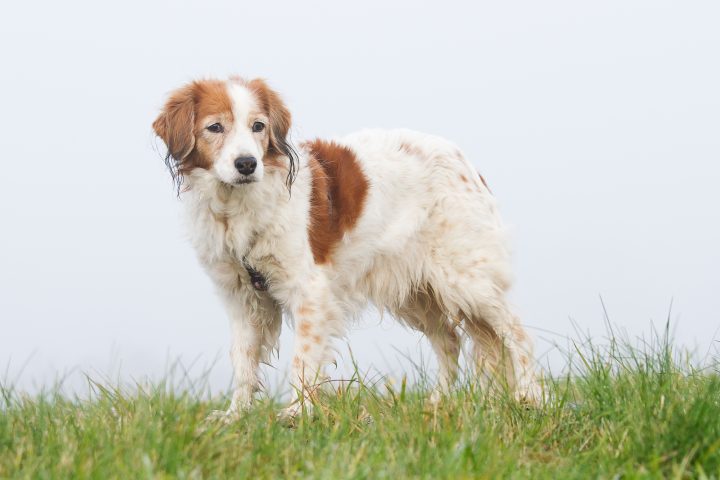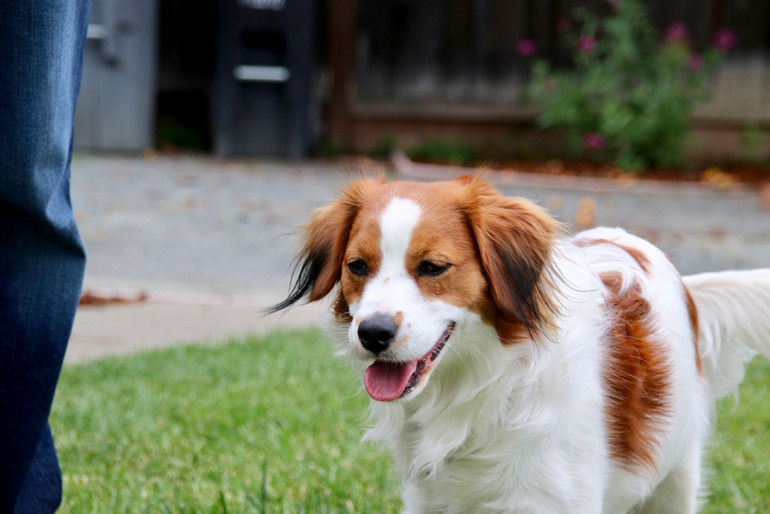The Kooikerhondje (Dutch for “small cager dog”) is a small spaniel-type breed of dog of Dutch ancestry that was originally used as a working dog, particularly in an eendenkooi (duck cage) to lure ducks. Kooikers were popular in the 17th and 18th century and appeared in the paintings of Rembrandt and Jan Steen. The breed is rapidly gaining popularity in the United States, Canada and Scandinavia, where it is still relatively unknown.
Appearance
The Kooikerhondje is a small, flashy, orange and white spaniel-like sporting dog. Originally bred in The Netherlands as a duck decoy dog, its heavily white plumed tail waves jauntily to entice and lure ducks to follow it into Eendenkooi (elaborate manmade pond trapping systems). When not working the traps, Kooikers were expected to work on the farm to catch vermin. The preferred height at the withers is 40 CM (16 inches in the USA) for males and 38 CM (15 inches in the USA) for females. The FCI standard allows variation of 38 to 41 CM for males, 36 to 39 CM for females. Allowable size in the United States is 14.5 to 17.5 inches for males, 13.5 to 16.5 inches for females. The proportion of Kooiker is off-square. The bone and substance of the Kooiker are moderate. The head should be in proportion to the dog. The expression is gentle and alert. Ears should be orange-red in colour and well feathered and ideally adorned with earrings. The colour for the Kooiker should preferably be distinct patches of clear orange-red on pure white although a few small spots on the legs are acceptable. Colour should be predominate on the back with the chest, belly, blaze and the majority of the legs and tail white. Black ear A black tail ring where the colour changes from orange-red to white is permitted. A dog who is solid red on the back is acceptable but not preferred.
History

The Kooikerhondje was developed in the Netherlands sometime prior to the sixteenth century to be a breed to lure ducks into traps – a technique also called tolling. They were used to lure ‘kooien’ (cages in the form of canals with traps at the ends), where the hunter (the so-called Kooiker) could easily catch the fowl. The dogs that were used by the Kooiker for this kind of hunting technique were referred to as the ‘Kooiker’s hondjes’ (literally: Kooiker’s dogs). Eventually, this led to this dog being called Kooikerhondje.
The breed almost became extinct during World War II until Baroness van Hardenbroek van Ammerstol rescued it. The breed was only officially recognized by the Raad van Beheer, the Dutch Kennel Club, in 1971 and has since been imported into other countries and recognised officially. The breed is still relatively unknown in North America and not yet recognized as a breed in Canada, although it was accepted into the AKC’s FSS program, in 2004. The breed was moved to the AKC Miscellaneous class on July 1, 2015, in preparation to moving to the Sporting Group upon full recognition. As of Jan 1, 2018, the Nederlandse Kooikerhondje has been fully recognized by the American Kennel Club and is now competing in the Sporting Group. In the United States, both the UKC and ARBA recognize the breed.
In the UK, the breed has been removed from the import list and is now eligible to enter Crufts for the Best in Show award, despite there being only 76 of the breed in the UK.
In January 2013, the Kennel Club announced it was re-classifying the Kooikerhondje from the gundog group to the utility group effective from January 2014. The decision was reached after discussions with the UK breed clubs and a unanimous agreement was achieved.
Some historians believe the Kooikerhondje may have possibly played a part in the development of the Nova Scotia Duck Tolling Retriever.
